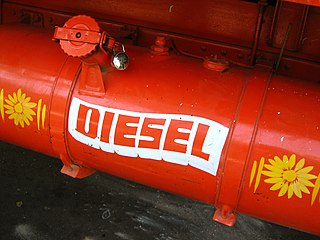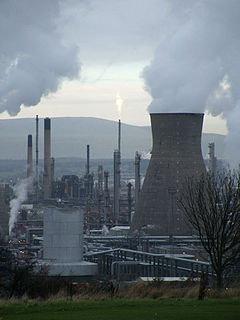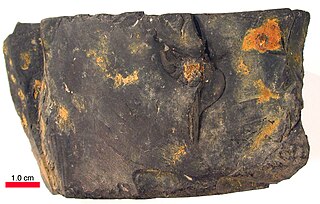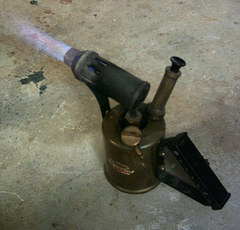Paraffin may refer to:
Kerosene, also known as paraffin, is a combustible hydrocarbon liquid which is derived from petroleum. It is widely used as a fuel in aviation as well as households. Its name derives from Greek: κηρός (keros) meaning "wax", and was registered as a trademark by Canadian geologist and inventor Abraham Gesner in 1854 before evolving into a genericized trademark. It is sometimes spelled kerosine in scientific and industrial usage. The term kerosene is common in much of Argentina, Australia, Canada, India, New Zealand, Nigeria, and the United States, while the term paraffin is used in Chile, eastern Africa, South Africa, Norway, and in the United Kingdom. The term lamp oil, or the equivalent in the local languages, is common in the majority of Asia. Liquid paraffin is a more viscous and highly refined product which is used as a laxative. Paraffin wax is a waxy solid extracted from petroleum.

Petroleum, also known as crude oil and oil, is a naturally occurring, yellowish-black liquid found in geological formations beneath the Earth's surface. It is commonly refined into various types of fuels. Components of petroleum are separated using a technique called fractional distillation, i.e. separation of a liquid mixture into fractions differing in boiling point by means of distillation, typically using a fractionating column. It consists of naturally occurring hydrocarbons of various molecular weights and may contain miscellaneous organic compounds. The name petroleum covers both naturally occurring unprocessed crude oil and petroleum products that are made up of refined crude oil. A fossil fuel, petroleum is formed when large quantities of dead organisms, mostly zooplankton and algae, are buried underneath sedimentary rock and subjected to both intense heat and pressure.

Paraffin wax is a soft colorless solid derived from petroleum, coal or oil shale that consists of a mixture of hydrocarbon molecules containing between twenty and forty carbon atoms. It is solid at room temperature and begins to melt above approximately 37 °C (99 °F), and its boiling point is above 370 °C (698 °F). Common applications for paraffin wax include lubrication, electrical insulation, and candles; dyed paraffin wax can be made into crayons. It is distinct from kerosene and other petroleum products that are sometimes called paraffin.

Waxes are a diverse class of organic compounds that are lipophilic, malleable solids near ambient temperatures. They include higher alkanes and lipids, typically with melting points above about 40 °C (104 °F), melting to give low viscosity liquids. Waxes are insoluble in water but soluble in organic, nonpolar solvents. Natural waxes of different types are produced by plants and animals and occur in petroleum.

Diesel fuel in general is any liquid fuel specifically designed for use in diesel engines, whose fuel ignition takes place, without any spark, as a result of compression of the inlet air mixture and then injection of fuel. Therefore, diesel fuel needs good compression ignition characteristics.

Mineral oil is any of various colorless, odorless, light mixtures of higher alkanes from a mineral source, particularly a distillate of petroleum, as distinct from usually edible vegetable oils.
Kerosene is a type of fuel, but it can also refer to:

White spirit (UK) or mineral spirits, also known as mineral turpentine (AU/NZ), turpentine substitute, and petroleum spirits, is a petroleum-derived clear liquid used as a common organic solvent in painting. There are also terms for specific kinds of mineral spirits, including Stoddard solvent and solvent naphtha (petroleum). Mineral spirits are often used as a paint thinner, or as a component thereof, though paint thinner is a broader category of solvent. Odorless mineral spirits (OMS) have been refined to remove the more toxic aromatic compounds, and are recommended for applications such as oil painting.

Jet fuel or aviation turbine fuel is a type of aviation fuel designed for use in aircraft powered by gas-turbine engines. It is colorless to straw-colored in appearance. The most commonly used fuels for commercial aviation are Jet A and Jet A-1, which are produced to a standardized international specification. The only other jet fuel commonly used in civilian turbine-engine powered aviation is Jet B, which is used for its enhanced cold-weather performance.
Paraffin oil may refer to:

Petroleum products are materials derived from crude oil (petroleum) as it is processed in oil refineries. Unlike petrochemicals, which are a collection of well-defined usually pure organic compounds, petroleum products are complex mixtures. The majority of petroleum is converted to petroleum products, which includes several classes of fuels.

Coal oil is a shale oil obtained from the destructive distillation of cannel coal, mineral wax, or bituminous shale, once used widely for illumination.
Tractor vaporising oil (TVO) is a fuel for petrol-paraffin engines. In the United Kingdom and Australia, after the Second World War, it was commonly used for tractors until diesel engines became commonplace. In Australian English it was known as power kerosene.

Asphaltenes are molecular substances that are found in crude oil, along with resins, aromatic hydrocarbons, and saturates. The word "asphaltene" was coined by Boussingault in 1837 when he noticed that the distillation residue of some bitumens had asphalt-like properties. Asphaltenes in the form of asphalt or bitumen products from oil refineries are used as paving materials on roads, shingles for roofs, and waterproof coatings on building foundations.
Higher alkanes are alkanes having nine or more carbon atoms. Nonane is the lightest alkane to have a flash point above 25 °C, and is not classified as dangerously flammable.
An oil is any nonpolar chemical substance that is a viscous liquid at ambient temperatures and is both hydrophobic and lipophilic. Oils have a high carbon and hydrogen content and are usually flammable and surface active. Most oils are unsaturated lipids that are liquid at room temperature.

Liquid paraffin, also known as paraffinum liquidum or Russian mineral oil, is a very highly refined mineral oil used in cosmetics and medicine. Cosmetic or medicinal liquid paraffin should not be confused with the paraffin used as a fuel. It is a transparent, colorless, nearly odorless, and oily liquid that is composed of saturated hydrocarbons derived from petroleum.
Crude oil is extracted from the bedrock before being processed in several stages, removing natural contaminants and undesirable hydrocarbons. This separation process produces mineral oil, which can in turn be denoted as paraffinic, naphthenic or aromatic. The differences between these different types of oils are not clear-cut, but mainly depend on the predominant hydrocarbon types in the oil. Paraffinic oil, for example, contains primarily higher alkanes, whereas naphthenic oils have a high share of cyclic alkanes in the mixture.

A blowtorch is a fuel-burning tool used for applying flame and heat to various applications, usually metalworking.
Bitumen froth treatment is a process used in the Athabasca oil sands (AOS) bitumen recovery operations to remove fine inorganics—water and mineral particles—from bitumen froth, by diluting the bitumen with a light hydrocarbon solvent—either naphthenic or paraffinic—to reduce the viscosity of the froth and to remove contaminants that were not removed in previous water-based gravity recovery phases. Bitumen with a high viscosity or with too many contaminants, is not suitable for transporting through pipelines or refining. The original and conventional naphthenic froth treatment (NFT) uses a naphtha solvent with the addition of chemicals. Paraffinic Solvent Froth Treatment (PSFT), which was first used commercially in the Albian Sands in the early 2000s, results in a cleaner bitumen with lower levels of contaminates, such as water and mineral solids. Following froth treatments, bitumen can be further upgraded using "heat to produce synthetic crude oil by means of a coker unit."